A dear friend of mine in Indore has always urged me to visit Mandu, or as it’s known locally in the Malwa region, Mandav. She describes it as one of the most romantic places to visit, especially during the monsoon months.
It had long been on my list of places to see, and then suddenly one Thursday, we decided to visit it on the upcoming weekend. The unplanned, spur-of-the-moment visit turned out to be one of the most memorable experiences, even after so many years have passed.
It helped that Mandu is very well connected. It’s just 28 kilometers from Dhamnod, a town on the Mumbai-Agra Highway.
As we arrived here, we were welcomed and pampered by people we only distantly knew, with such amazing hospitality that we were overwhelmed. Buoyed by such a great start to the day, we were in an amazing mood by the time we reached Mandu on that September weekend.
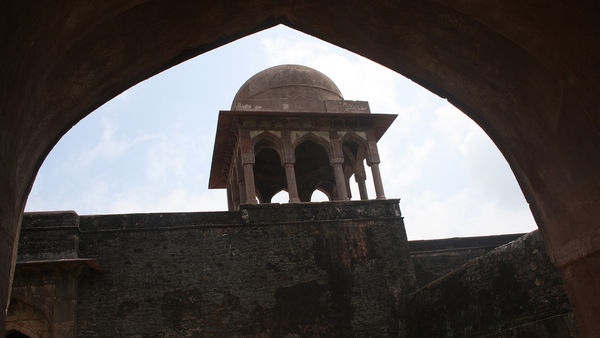
We began our journey by visiting Baj Bahadur Palace and Rani Rupmati’s Pavilion. Despite having a guide who, to both our horror and hilarity, painted amusing pictures of the past with unnecessary bravado, and whom we promptly parted ways with, the place connected with us though its courtyards , hidden staircase, water bodies and beautiful setting .
These ruins had a story to tell about the impossible romance between Baj Bahadur and Rani Rupmati. Our experience was further enriched by a local who played melodious tunes on the flute, transporting us to the era when the lovers must have roamed those hauntingly beautiful places. Their romantic tale tragically ended as the Mughals invaded Mandu. Yet, their folklore continues to engage and mesmerize both locals and visitors alike.
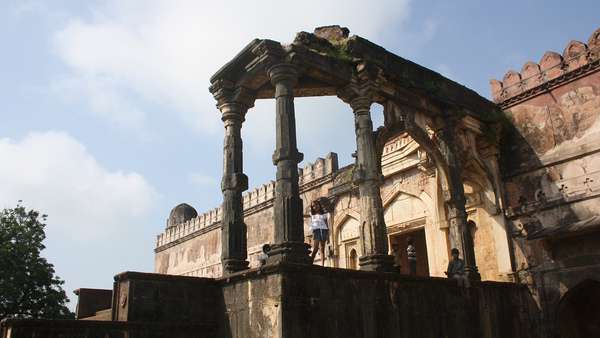
As we moved to the main and most visited complex, the Royal Enclave, it started raining heavily. Indeed, this is one of the places you should visit in the monsoon. As everyone ran for shelter, the complex presented itself as a rain-soaked feminine beauty, with the wetness only enhancing the contours and textures of Jahaz Mahal, bewitching the unsuspecting observer.
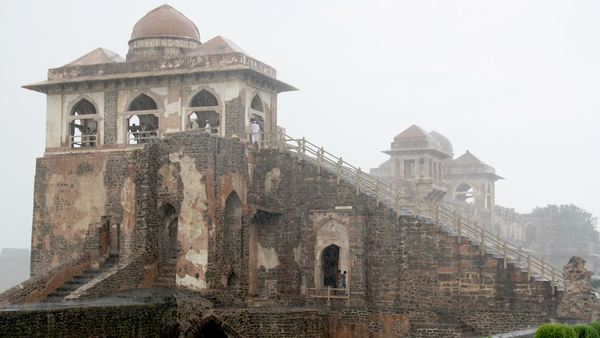
Once the rain receded, a fresh and pristine beauty of the whole complex emerged, captivating all and making everyone joyously explore the complex. As evening approached, we continued to explore the complex with a newfound and knowledgeable guide. An urge to revisit the complex on my own again the next morning developed, ending the day on a high and hopeful note.
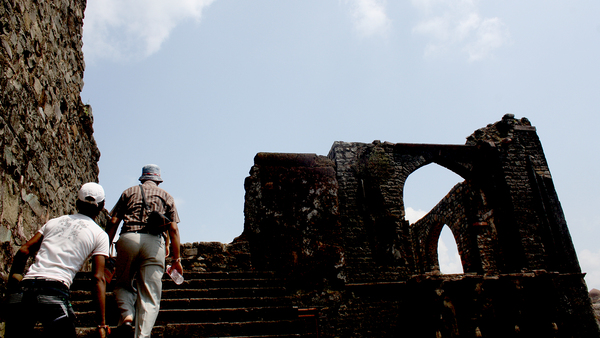
The next day turned out to be a day of time travel. As we explored various zones and places, including Dai ka Mahal (yes, a palace for the Royal Nanny!), Dai ki Behen ka Mahal, Malik Mughith Masjid, and Caravan Sarai, we found ourselves as the sole visitors. These places came alive around us. The architecture of the place, even in ruins, has the power to evoke emotions, create memories, and transport you to a realm which does not belong to the present.
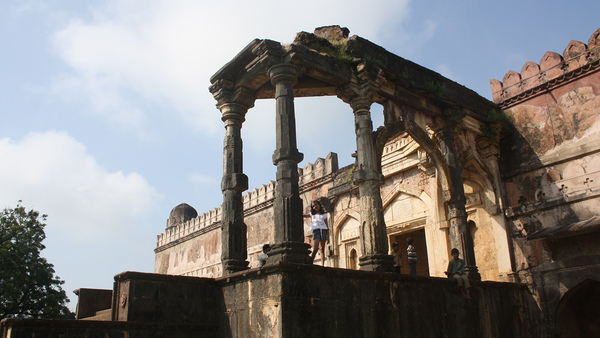
We proceeded towards the Royal Enclave immediately afterwards. This is the most significant and celebrated zone of Mandu, and rightly so. When you visit it, the place feels like poetry spoken in the words of brick and mortar. It can move you, it can make you dreamy. But mostly what it does is make you play and get lost in its labyrinth.
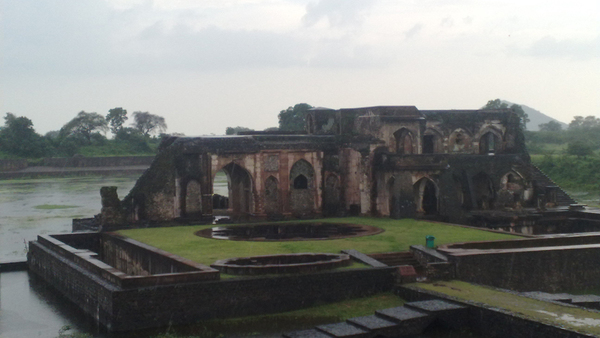
As you move from the bright and airy chambers of Jahaz Mahal to the dark depths of Chand Baoli with its multiple levels of darkness, and the Hamam with its beautiful play of light, encountering the magnificent Hindola Mahal on your way, the journey becomes a captivating experience. As you continue to Jal Mahal, a building with a brilliant water system in place, you marvel at the wisdom and vision of the ancients.
The journey itself is by no means less engaging than a good novel or a well-made movie. You love to get lost as you discover dark alleys, hidden niches, bright courtyards, and grand, inviting halls, all ready to welcome you in.
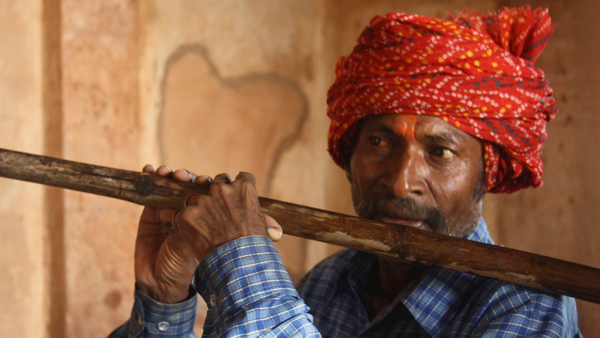
A visitor’s readiness to engage can make her visit to the place a story to remember for a lifetime. Our visit to this complex in the morning sun only heightened the emotion and experience of time travel.
As we explored the Jama Masjid, Asharfi Mahal, and the Tomb of Hoshang Shah in the vicinity, we realized that each place has its own story. These stories are not told through words, but through the spaces, arches, domes, stones, scale, light, and darkness, as the buildings converse with the visitors.
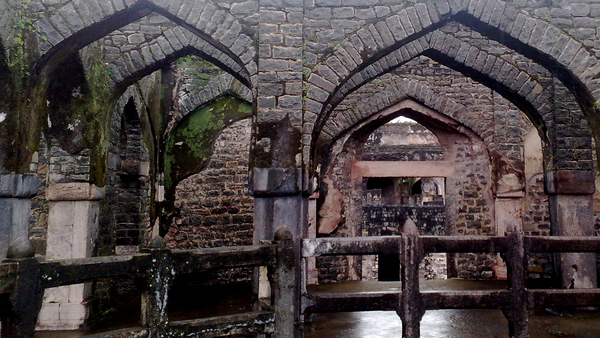
A visit to Mandu turned out to be surrealistic, as it became a journey to the past within the past. It’s as if the whole place, with its palaces, mosques, sarais, and tombs, is frozen in the time of its owners. The emperors and inhabitants built this city with much pomp, grandeur, and love, and now the buildings retell everyone of a vibrant past that was once filled with life and splendor.
The place stands witness to the time it spent in those centuries, still speaking to each visitor about those times. It takes them through its layers and makes them part of its charm.
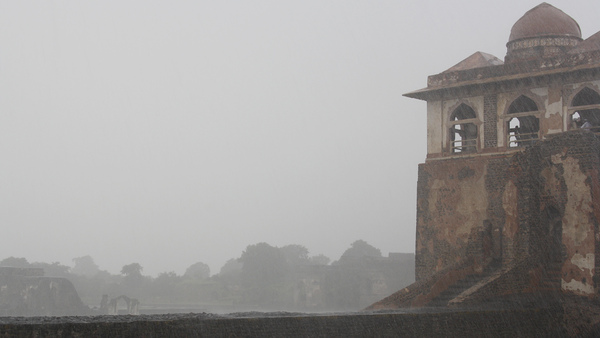
We left the city, visiting the dilapidated yet magnificent ruins of Gada Shah’s shop and the mandatory Delhi Gate on our way out. We were enchanted, dreamy, and lost in our recent adventure of time travel.
A visit to Neelkanth Mandir, built by Emperor Akbar on the outskirts as we were leaving the town, provided a serene and tranquil end to our journey. The temple’s peaceful atmosphere and spiritual ambiance brought us back to the realm of reality after our enchanting exploration of Mandu.
I would highly recommend this place at the heart of Malwa to all the dreamers out there who believe in the romance and adventure of time, because as someone has rightly said, “Every moment is a gateway to the past or the future; we just have to learn how to step through.” Here,
in Mandu, you’ll find your place and moment – it’s a destination where the beauty of the present intertwines with the mysteries of the past, offering a timeless experience that transcends ordinary travel. Embrace the magic of Mandu, and let its enchanting allure transport you to realms where dreams and reality meet.
How to Reach Mandu?
By Air:
The nearest international airport is in Indore, 95 kilometres away. Regular flights linking Indore to Delhi, Mumbai, Gwalior, and Bhopal.
By Train:
The closest station on the main Delhi-Mumbai line is Ratlam, which is 132 km away.
By Road:
Mandu has excellent connections to neighbouring states and other cities in MP. Mandu is connected to Indore, Ujjain, Ratlam, and Bhopal via regular bus services. City is around 278 km from Bhopal, 124 km from Ratlam and 90km from Indore.
Where to Stay:
There aren’t many places to stay in the town. The Madhya Pradesh Tourism Development Corporation (MPTDC) offers lodging that is both luxurious and reasonably priced. You can take a day trip to Mandu from Maheshwar or Indore, where you can stay.
Best Time to Visit:
October through March is the best time of year to visit Mandu. Wintertime temperatures are pleasant all day long, with the highest recorded temperature reaching 27 or 28 degrees Celsius.
Things to Remember:
Carry enough water (we or cap, and sunscreen because there will be a lot of walking. The daytime high in the winter can reach 30 degrees Celsius. A local guide must be hired in order to show you everything more effectively. Mandu is known for its daal paniye and daal baafle. Try some of the regional food.